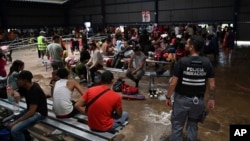Nicaragua has become a hot spot for migrants from around the world seeking to avoid a brutal trek through the Darien Gap jungle.
Migrants from South American and Caribbean countries, Africa and Asia, have long had to brave the lawless, virtually impassable rainforest that straddles Panama and Colombia, in a bid to reach the United States.
However, analysts say that the government of Nicaragua’s President Daniel Ortega, a longtime nemesis of the United States, has deliberately made it easier for migrants to bypass the Darien by flying straight into his country and then heading north overland.
Manuel Orozco, a migration expert at the Washington-based Inter-American Dialogue, told AFP that Ortega’s government was facilitating “the business of a network of international air services” so that migrants “can reach the border with Mexico and the United States faster.”
“We collected data from more than 500 charter flights,” said Orozco, adding that between April and June, airport authorities had hired “private companies located in Dubai to train officials in the international handling of paperwork for these types of flights.”
Orozco said that the Nicaraguan government, which has remained silent on the matter, benefits from the cost of visas or tourist cards, depending on the nationality of the arriving passenger, as well as landing taxes.
He said that for Nicaragua, the new air route is an “opportunity to worsen the migration crisis to the United States and, in the process, make money.”
An Airbus A340 was detained last week at a Paris airport after an anonymous tip that it was carrying potential victims of human trafficking. After it was established that the passengers were traveling of their own free will, most of them were flown back to India on Monday.
Indian police said the passengers had paid tens of thousands of dollars to agents to help them reach the southern border of the United States.
Liliana Bakayoko, a lawyer for the Romanian airline operating the flight, told AFP that Nicaragua had approved the passenger list before the plane departed.
From the capital, Managua, migrants travel to Honduras and Guatemala, then to Mexico to the southern border with the United States, paying thousands of dollars to smugglers.
This allows them to avoid the Darien Gap, where on top of the dangers of the thick jungle, rivers, and wild animals, they are preyed upon by criminal gangs and face sexual violence.
Panamanian authorities say more than half a million people made it through the jungle in 2023, double the amount the previous year.
Most of those braving the Darien Gap are Venezuelans fleeing economic misery, but there are also Ecuadorans, Haitians, Cubans, Chinese, Vietnamese, Afghans and Africans from Cameroon or Burkina Faso.
The International Organization for Migration has said the “most significant trend has been the shift by Cuban migrants and those coming from African nations who are increasingly choosing air routes to reach Central America, sidestepping the Darien to continue their northbound trip.”
Honduras migration statistics show a five-fold increase in arrivals from countries like Guinea, China, Senegal, India, Afghanistan and Angola, who cross into the country from Nicaragua.
Orozco said that Nicaragua has also become a “springboard” for Cubans and Haitians taking charter flights since visa requirements for those countries were scrapped in 2021.
Others take regular commercial flights to El Salvador, which in October imposed an airport transit fee of $1,130 on Africans and Indians.
Most of them “are destined for Nicaragua” a spokesperson for El Salvador’s immigration authority told AFP.
Colombia says that the majority of passengers arriving from Turkey are Africans in transit to San Salvador and then to Nicaragua.
“It is a population which has means to pay, an intention to migrate and which pays for tickets and other things to avoid going through the Darien,” Colombia’s deputy foreign minister Francisco Coy said this week after two children from Guinea were found abandoned in a Bogota airport.

